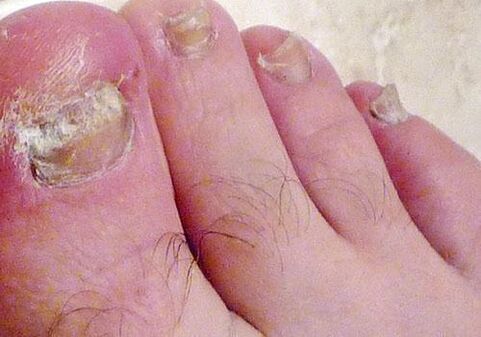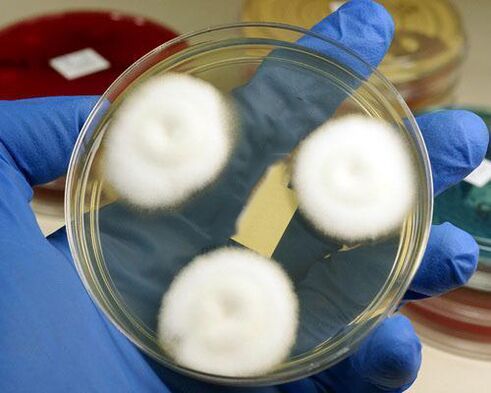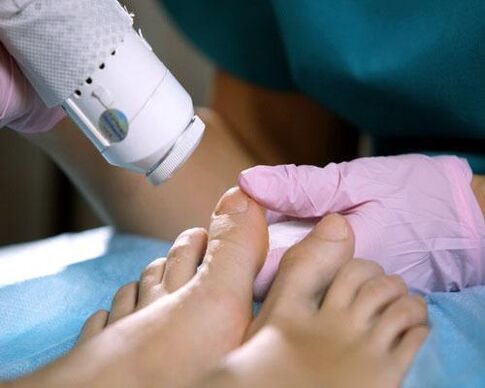
Onychomycosis is a disease caused by representatives of the fungal microflora, which causes a gradual destruction of the nail plate by changing the structure, color and shape of the nails of the hands and feet.
The causes of onychomycosis include three types of fungi:
- Dermatomycetes. Dermatomycetes are parasitic fungi, the main representatives of which are Trichophyton, Microsporum, Epidermophyton. Dermatomycetes are the source of nail fungus in 80-85% of the time.
- Candida fungi (like yeast). Candida is present in the microflora of any human body, but by nature begins to multiply rapidly and cause nail fungus. Candida fungus infects the nail surface in 8-10% of cases.
- Moldy. Mold is one of the rarest possible causes of nail fungus; only 5-6% are infected.
Causes of nail fungus
Onychomycosis occurs in 100% of cases as a result of skin damage by mycotic pathogens. Contact of the skin of the foot with the infected surface causes the fungus to penetrate the nail from the upper layers of the epithelium, resulting in further deformation of the nail plate. Depending on the location of the lesion, the following types of onychomycosis are possible:
- The fungus enters the nail bed from the outer surface of the nail. In the first days of infection, it is difficult for the patient to feel any changes, as they are almost asymptomatic. However, as the fungus grows in the nail bed, hyperkeratosis begins to develop. Hyperkeratosis is caused by a change in nail color from light pink to yellowish, and the connection between the nail surface and the nail bed is weakened, which leads to delamination and peeling.
- The fungus can enter the nail from the free surface of the nail plate. This occurs when the spores have a high keratolytic capacity (rapidly destroying keratin). In this case, the nail infection is faster than the first option.
- From the nail layer (the area of skin adjacent to the nail plate). It is a little less common, but with this method of infection, the inflammatory process of the nail matrix (root zone) can begin.
Risk factors for fungal nail infection
- straight legs or other features of the structure, the development of the foot;
- varicose veins of the legs;
- Decreased immunity to previous diseases;
- HIV infection;
- increased sweating;
- wear shoes and clothes made of synthetic materials;
- lower leg ventilation. It reappears thanks to uncomfortable and narrow shoes;
- mechanical damage to the foot;
- scratches, abrasions, open wounds;
- self-extraction of a nail inside;
- frequent use of antibiotics;
- candidiasis (mainly in women);
- co-morbidities. Diabetes mellitus, thyroid disorders, dermatological diseases, diseases of the stomach, pancreas, overweight can also increase the risk of onychomycosis by 6-8 times;
Well, in addition to these factors, there are ways to get nail fungus.
- Use of personal hygiene products (pumice stone, clothes, slippers, pants)
- To visit public saunas, baths, swimming pools, dressing rooms without shoes.
- Wearing someone else's shoes
- Non-compliance with sterilization standards in beauty salons (especially pedicures).
Symptoms and forms of onychomycosis
Symptoms of the disease depend on many factors: age, form of onychomycosis, the degree of infection, the condition of the body as a whole. Symptoms of nail fungus infection are accompanied by itching, burning and skin irritation.
Currently, dermatologists identify five main forms of nail fungus damage:
- Hypertrophic. It is characterized by a sharp thickening of the nail plate. The thickness of the nail can be more than 3-4 mm - this is due to the increase in small skin scales that grow on the infected surface of the nail. The sides of the nail plate are the most destroyed; the middle (central) part, on the contrary, thickens. The nail on the edges begins to fall out strongly. Due to hypertrophic damage, the nail becomes curved, narrow and very thick. In addition, there is a sharp change in nail color, accompanied by peeling.
- Normotrophic. It is the easiest form, because when the fungus is affected, the nail does not thicken, it remains the same. Only the color of the nail plate changes. The fungus begins with the appearance of a small yellow spot and then grows rapidly. If you do not consult a specialist and do not start treatment, over time, the size of the stain will increase, gradually occupying the entire area of the nail plate. Because a person can quickly detect a discoloration, onychomycosis can be diagnosed at a fairly early stage of the disease.
- Atrophic (Onycholytic). The atrophic form of onychomycosis is accompanied by a sharp change in nail color from pink to gray, followed by the destruction of the nail structure. It is characterized by rapid progression and as a result leads to complete separation of the nail plate from the nail bed. In other words, the patient may accidentally close or remove the infected nail and completely "remove" it. The final stage of atrophic fungi is necrosis of nail tissue.
- Lateral and distal. The lateral form is often diagnosed in conjunction with the distal fungal type. The symbiosis of these species causes a change in the color of the nail plate, starting with the appearance of longitudinal yellowish threads, and then an increase in the area of nail damage. Within 4-5 weeks, without proper treatment, nail cells begin to die and the nail itself collapses violently. The final stage of a lateral nail lesion by a fungus is a complete exposure of the nail bed, which is dangerous with the risk of infection of the mucous membrane.
- General form of onychomycosis. A common nail fungus is the lack of treatment for any of the above types of onychomycosis. Keep in mind that the nail changes color very quickly, erodes, breaks, and then completely abandons the nail bed. In this case, you need to consult not only a dermatologist, but also a surgeon.
Stages of onychomycosis
In order to avoid nail fungus, you should not forget that in addition to the deformation of the nail, the infection does not occur overnight. From a medical point of view, this is the primary lesion, the normotrophic stage and the hypertrophic stage of the disease.
In the initial stage, the nail is affected only from the edges; at the same time the size of the affected area is not more than 2-3 mm. In rare cases, the free edge of the nail may be affected. The skin of the feet is infected before the nail is directly damaged. The patient feels itching, friction and tingling, painful calluses may appear. Over time, the fungus passes from foot to toe. If you notice changes at this point and consult a specialist, you have a chance to completely protect and restore the nail plate in a short time.
The normotrophic stage is the next stage of the disease. Thickening of the nail plate is an intermediate process that has not yet begun, but the affected areas of the nail are already noticeable. Affected areas may be small (2-4 mm) or larger (more than 5 mm). Often they are expressed in the form of thin vertical stripes of yellowish color. The first manifestation of nail fungus is a clear color change: it can be noticed quickly and you can start treatment on time.
The last stage of onychomycosis is the hypertrophic stage of the disease. It starts with the formation of a small spot under the nail, then grows very quickly. An inflammatory process that accompanies the formation of purulent sacs may be accompanied. The nail plate thickens, crumbles, erodes, then sharpens sharply, and finally the nail cells die and are completely eroded.
Important: The risk of hypertrophic nail damage is also related to the possibility of damage to nearby skin and the transition to a chronic level. However, such a development is possible only in the absence of timely medical intervention and subsequent treatment of nail fungus.
Nail fungus treatment
The most common are various antifungal drugs. The mechanism of action of such drugs is reduced not only to the direct destruction of spores, but also to the accumulation of the active substance in the nail plate. This prevents relapses and protects the feet from possible future injuries.
Before choosing one or another drug, you must undergo a microbiological culture to determine the type of nail fungus, make a complete diagnosis and consult a dermatologist.

The most modern dermatological clinics use the following methods to diagnose onychomycosis:
- KOH microscopy
- High-sensitivity PCR diagnostics
Before prescribing a particular drug, a dermatologist should consider the nature of the fungal infection, the type of onychomycosis, the time elapsed since the infection, and more.
The most commonly used treatments: medicine, laser and traditional medicine.
Medication
The most common antifungal drugs are varnishes, ointments and tablets.
In the early stages of the fungus, it is recommended to use local preparations, in which antifungal varnishes play an important role.
Important: If a doctor prescribes an antifungal varnish, the procedure should never be skipped, otherwise it will not have the desired effect.
In addition to varnishes, there are special ointments and gels that have the same antifungal effect. Ointments also belong to local preparations. Specialists often prescribe ointments. The ointment should be applied to the affected areas of the nail and foot for a certain period of time. The exact time of treatment is determined by a specialist.
There are also antifungal pills. Unlike ointments and varnishes, tablets are general-purpose oral medications. Most commonly prescribed antifungal pills: Tablets are usually prescribed not in the early stages of infection, but later when the fungus enters the normotrophic phase.
Laser Fungal Treatment

Currently, some clinics offer laser nail fungus treatment. The laser beam penetrating the subungual surface heats it up to the growth zone, thereby killing the fungus and stimulating the growth of a new nail. Research has shown that fungal microorganisms die when the nail plate is systematically heated to 60-70 degrees. A similar thermal effect can be achieved only with the help of laser beams without damaging the surrounding tissues, because the laser beam has a length that only reacts to cells affected by mycoses. Although the laser lesion method promises complete removal of nail fungus, dermatologists usually recommend several sessions of such treatment. Compared to drug treatment, this method is more expensive and therefore not suitable for everyone.
And for those who are lazy to see a doctor, there are medicines from the arsenal of traditional medicine
Experts recommend resorting to folk remedies only in combination with ongoing systematic traditional treatments. Such funds can be used as a preventive measure to eliminate the possibility of recurrence of the fungus in the future.
Here are some recipes that are very likely to be effective in the treatment of nail fungus, but not necessary. However, the use of these simple recommendations is prohibited unless there are other opportunities to combat onychomycosis.
- Affected areas of the nail plate are treated twice a day with 5% iodine solution. When iodine is applied, a slight tingling and burning sensation may be felt. If anxiety worsens, such treatment should be discontinued and other treatments instituted.
- A tincture of 20% propolis is prepared, then applied to the affected skin and nail areas of the fungus. The action of propolis is to promote the rapid regeneration of damaged cells and the regeneration of the nail. The effect of propolis is noticeable only after a few applications.
- One of the most popular ways to fight fungus alone is to use kombucha. To make a compress, you need to cut a small piece of ripe kombucha, tie the fungus to the affected nail and use a bandage or gauze bandage to leave overnight. Open the bandage in the morning and remove dead nail particles. The affected area and surrounding skin should then be treated with iodine solution or another disinfectant. It is recommended to continue working the nail with kombucha for 3-4 weeks.
Prevention of nail fungus infection
- Preventing any disease, including onychomycosis, is easier than treating it. To protect yourself from nail fungus and minimize your risk of infection, you need to follow simple preventative measures that will help you stay healthy.
- Above all, it is important to follow personal hygiene, especially in public places. This applies to both your home and public places such as saunas and baths. You should always wear individual slippers and use your own loofah and pumice stone for heel care.
- If you notice that your feet are sweating excessively, you should change your shoes or use a special refreshing pad. These soles have a porous structure, so they normalize air circulation.
- Regularly check your feet for micro-cracks, scratches and cuts. If scratches are found, you should treat the area with antiseptics (alcoholic solution of iodine, etc. ).
Like many other diseases, nail fungus cannot be seen immediately, so it is very important to monitor the condition of the skin of the nails and feet. And it is best to carefully follow all the prescribed preventive measures - in the future, these simple actions will save time and money spent on treatment.





























